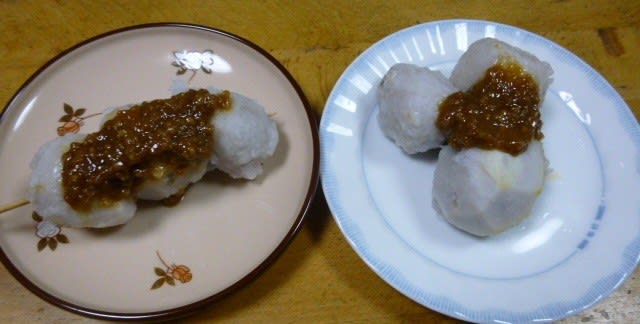金時草のおひたし
久しぶりに金時草を友人が持参して頂き、おひたしに。
キンジソウの名の由来は、裏面の色が「金時芋」に似た美しい赤紫色である事から「金時草」と呼ぶようになったらしい。18世紀に中国から渡来したものであるが、九州の熊本市で古くから栽培されて、江戸時代以降、石川県で栽培されている、金沢の友人に貰い、挿し木をしておいたら見事に成長したので調理をしました。



①葉を塩茹でして、暫く水に晒し、水切り。
②三倍酢で味付けして置くと、酢酸で色が赤紫に発色してくる。色と風味とヌルミを味わえる。
キンジソウ(和名スイゼンジ菜)の名の由来は、裏面の色が「金時芋」に似た美しい赤紫色である事から「金時草」と呼ぶようになったらしい。18世紀に中国から渡来したものであるが、九州の熊本市(はんだま)で古くから栽培されて、江戸時代以降、石川県の一部の集落で栽培されている、金沢の友人に貰い、挿し木をしておいたら見事に成長したので調理をしました。
料理は胡麻の味噌和え・天ぷら・酢の物・しゃぶしゃぶ・おしたし等がある
茎は円柱形でよく分枝し、紫褐色。葉は長楕円形で先が尖る。表は緑、裏は紫色で、柔軟・粘液質である。葉と若い茎を食用にし、夏場の野菜として独特の風味があり、ゆでるとぬめり(粘り)がでる。
生育適温は20~25℃で、冬季には地上部が枯死する。耐暑性がすこぶる強く、夏季には良く繁茂する。半日日陰で温度差が大きいと葉の裏の赤紫色がきれいに出る。土壌の適応性は広いが乾燥には弱い。
作型は普通栽培で、定植は4月下旬から5月上旬に行い、収穫は定植後50~60日目ごろから随時収穫。
Kin toki grass
After a long absence, my friend brought kin toki grass with me.
The origin of the name of Kingisou seems to have come to be called "Kintoki grass" because the color on the back is a beautiful reddish purple similar to "Kintokiimo". Although it was introduced from China in the 18th century, it was cultivated from ancient times in Kumamoto City, Kyushu, and cultivated in Ishikawa Prefecture since the Edo period, and it was given by a friend in Kanazawa, and when I cut it, I cooked it because it grew beautifully.


①Boil the leaves with salt, expose them to water for a while, and drain.
② When seasoned with triple vinegar and placed, the color is reddish purple with acetic acid. You can taste the color, flavor and nurumi.
The origin of the name of Kinjisou (Japanese name Suizenjina) seems to have come to be called "Kintoki grass" because the color on the back side is a beautiful reddish purple similar to "Kintoki potato". Although it was introduced from China in the 18th period, I got it from a friend in Kanazawa who was cultivated since ancient times in Kumamoto City (Solderma) in Kyushu and cultivated in some villages in Ishikawa Prefecture since the Edo period, and I cooked it because it grew beautifully when I cut it.
Dishes are sesame with miso, tempura, vinegared dishes, shabu-shabu, and rice
The stem branches well in a cylindrical shape and is purple-brown. The leaves are oval-shaped and pointed. The front is green, the back is purple, and it is flexible and mucus. Leaves and young stems are edible, and there is a unique flavor as a vegetable in summer, and when boiled, slimy (sticky) comes out.
The temperature suitable for growth is 20 to 25 °C, and the aboveground part dies in winter. It has a strong heat resistance and grows thick in summer. When the temperature difference is large in the shade of half a day, the reddish purple color on the back of the leaf comes out beautifully. The adaptability of the soil is wide, but weak for dryness.
The crop cultivation is usually cultivated, planting is done from late April to early May, and harvesting is harvested from around the 50th to 60th days after planting.



















































